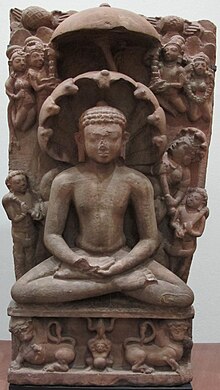Pārśva
| Parshvanatha | |
|---|---|
| 23rd Jain Tirthankara | |

Image of Tīrthankara Parshvanatha (Victoria and Albert Museum, 6th–7th Century)
|
|
| Venerated in | Jainism |
| Symbol | Snake |
| Height | 9 cubits (13.5 feet) |
| Age | 100 years |
| Color | Blue |
| Spouse | Prabhavati |
| Parents |
|
| Predecessor | Neminatha |
| Successor | Mahavira |
| Born | 872 BCE Varanasi |
| Moksha | 772 BCE Shikharji |
Parshvanatha (Pārśvanātha), also known as Parshva (Pārśva), was the 23rd of 24 Tirthankaras (ford-maker, teacher) of Jainism. He is the earliest Jain Tirthankara who is generally acknowledged as a historical figure. His biography is uncertain, with Jain sources placing him between the 9th and 8th century BC, while historians stating he may have lived in 8th or 7th century BC. Along with Mahavira, Rishabhanatha and Neminatha, Parshvanatha is one of the four Tirthankaras who attracts the most devotional worship among the Jains. His iconography is notable for the serpent hood over his head, and his worship often includes Dharanendra and Padmavati – the serpent god and goddess of Jainism.
Parshvanatha is said in Jain texts to have been born in Benares (Varanasi, India), renounced the worldly life and founded an ascetic community. He is credited with starting the tradition of "four fold restraints" for monks – don't kill, don't steal, don't lie and don't own property. Some Jain texts, such as section 2.15 of Acaranga Sutra, state that Mahavira's parents were followers of Parshvanatha, linking Mahavira to a pre-existing theology and as a reformer of pre-existing Jain mendicant tradition. Mahavira expanded the scope of Parshvanatha's first four restraints, with his ideas on Ahimsa (non-violence), giving up even clothes, and added the fifth monastic vow of celibacy in the practice of asceticism. Parshvanatha, in contrast, had not required celibacy, and had allowed the wearing of simple outer garments by monks. The differences between the ideas of Parshvanatha and Mahavira, have been one of the many historic foundations behind the disputes between the two major Jain sub-traditions – Svetambaras and Digambaras.
Parshvanatha's popularity among Jains is widespread, according to Paul Dundas – a professor of Sanskrit known for his publications on Jainism. Parshva is popularly seen as a ford-maker who removes obstacles and has the capacity to save. Parshvanatha died on Mount Sammeta (Madhuban, Jharkhand) along the River Ganges basin, a place that has been an important pilgrimage site for all sub-traditions within Jainism.
...
Wikipedia
